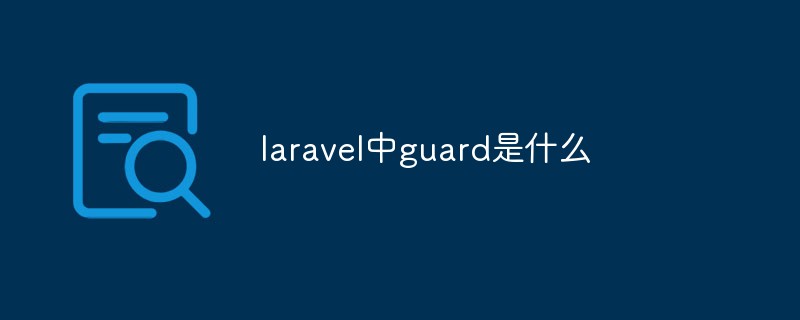 PHP Framework
PHP Framework Laravel
Laravel API Authentication and Authorization with Laravel: Protecting Sensitive Data and Operations
API Authentication and Authorization with Laravel: Protecting Sensitive Data and Operations
Using Laravel for API authentication and authorization: protecting sensitive data and operations
Overview:
API (Application Programming Interface) is an important part of modern web application development component, which allows data interaction and function calls between various systems. In API applications, data security is crucial. Laravel is a popular PHP framework that provides powerful API authentication and authorization functions, which can help us protect sensitive data and operations and prevent unauthorized access.
1. Install and configure Laravel
First, we need to use composer to install Laravel. Run the following command in the command line:
composer global require laravel/installer
After the installation is complete, we can use the following command to create a new Laravel project:
laravel new api-auth
Enter the directory where the project is located:
cd api-auth
Next, we need to generate a key to encrypt our user data. Run the following command:
php artisan key:generate
2. Create API authentication and authorization related files
- Create user model: In Laravel, we often use the Eloquent model to manage data in the database. Run the following command to generate a User model:
php artisan make:model User -m
This command will generate a User model and the corresponding database migration file.
- Create a user authentication controller: Run the following command to generate a user authentication controller:
php artisan make:controller AuthController
- Create an API route: Edit
routes/api. phpfile, defining API-related routes:
Route::post('login', 'AuthController@login');
Route::post('register', 'AuthController@register');
Route::middleware('auth:api')->group(function () {
Route::get('user', 'AuthController@user');
Route::post('logout', 'AuthController@logout');
});The above routes define user login, registration, user information acquisition, logout and other interfaces.
- Writing user authentication controller: Open the
app/Http/Controllers/AuthController.phpfile and write the following code:
namespace AppHttpControllers;
use IlluminateHttpRequest;
use AppUser;
use IlluminateSupportFacadesAuth;
class AuthController extends Controller
{
public function register(Request $request)
{
$validatedData = $request->validate([
'name' => 'required|max:55',
'email' => 'email|required|unique:users',
'password' => 'required|confirmed'
]);
$validatedData['password'] = bcrypt($request->password);
$user = User::create($validatedData);
$accessToken = $user->createToken('authToken')->accessToken;
return response(['user' => $user, 'access_token' => $accessToken]);
}
public function login(Request $request)
{
$loginData = $request->validate([
'email' => 'email|required',
'password' => 'required'
]);
if (!Auth::attempt($loginData)) {
return response(['message' => 'Invalid credentials']);
}
$accessToken = Auth::user()->createToken('authToken')->accessToken;
return response(['user' => Auth::user(), 'access_token' => $accessToken]);
}
public function user()
{
return response(['user' => Auth::user()]);
}
public function logout(Request $request)
{
$request->user()->token()->revoke();
return response(['message' => 'Successfully logged out']);
}
}In the above code , we define user registration, login, obtaining user information and logout operations.
3. Configure API authentication and authorization
- Configure Guard and Provider: Open the
config/auth.phpfile and findguardsandprovidersConfiguration items, configure according to the following example:
'guards' => [
'web' => [
'driver' => 'session',
'provider' => 'users'
],
'api' => [
'driver' => 'passport',
'provider' => 'users',
]
],
'providers' => [
'users' => [
'driver' => 'eloquent',
'model' => AppUser::class
]
],- Run database migration: Run the following command to execute the generated database migration:
php artisan migrate
- Configure Passport: Run the following command to publish the Passport configuration file:
php artisan passport:install
After execution, a pair of encrypted public and private keys will be generated for issuing and verifying access. Token.
- Create a personal access client: Run the following command to create a personal access client:
php artisan passport:client --personal
5. Test API authentication and authorization
- Register a new user: Use a POST request to
http://localhost:8000/api/registerto send the following data:
{
"name": "John Doe",
"email": "johndoe@example.com",
"password": "password",
"password_confirmation": "password"
}- Log in a user: Use a POST request to
http://localhost:8000/api/loginSend the following data:
{
"email": "johndoe@example.com",
"password": "password"
}- Get user information: Use GET request to
http://localhost: 8000/api/userSend a request and addAuthorization: Bearer {access_token}in the Headers, where{access_token}is the access token returned when logging in. - Log out the user: Use POST request to send a request to
http://localhost:8000/api/logout, also addAuthorization: Bearer {access_token}in the Headers .
Above, we have successfully protected sensitive data and operations through Laravel's API authentication and authorization functions. Using the user model, controller, routing and the functions provided by Passport, we can easily implement authentication and authorization control of the API.
The above is the detailed content of API Authentication and Authorization with Laravel: Protecting Sensitive Data and Operations. For more information, please follow other related articles on the PHP Chinese website!
 laravel单点登录方法详解Jun 15, 2022 am 11:45 AM
laravel单点登录方法详解Jun 15, 2022 am 11:45 AM本篇文章给大家带来了关于laravel的相关知识,其中主要介绍了关于单点登录的相关问题,单点登录是指在多个应用系统中,用户只需要登录一次就可以访问所有相互信任的应用系统,下面一起来看一下,希望对大家有帮助。
 一起来聊聊Laravel的生命周期Apr 25, 2022 pm 12:04 PM
一起来聊聊Laravel的生命周期Apr 25, 2022 pm 12:04 PM本篇文章给大家带来了关于laravel的相关知识,其中主要介绍了关于Laravel的生命周期相关问题,Laravel 的生命周期从public\index.php开始,从public\index.php结束,希望对大家有帮助。
 laravel中guard是什么Jun 02, 2022 pm 05:54 PM
laravel中guard是什么Jun 02, 2022 pm 05:54 PM在laravel中,guard是一个用于用户认证的插件;guard的作用就是处理认证判断每一个请求,从数据库中读取数据和用户输入的对比,调用是否登录过或者允许通过的,并且Guard能非常灵活的构建一套自己的认证体系。
 laravel中asset()方法怎么用Jun 02, 2022 pm 04:55 PM
laravel中asset()方法怎么用Jun 02, 2022 pm 04:55 PMlaravel中asset()方法的用法:1、用于引入静态文件,语法为“src="{{asset(‘需要引入的文件路径’)}}"”;2、用于给当前请求的scheme前端资源生成一个url,语法为“$url = asset('前端资源')”。
 实例详解laravel使用中间件记录用户请求日志Apr 26, 2022 am 11:53 AM
实例详解laravel使用中间件记录用户请求日志Apr 26, 2022 am 11:53 AM本篇文章给大家带来了关于laravel的相关知识,其中主要介绍了关于使用中间件记录用户请求日志的相关问题,包括了创建中间件、注册中间件、记录用户访问等等内容,下面一起来看一下,希望对大家有帮助。
 laravel中间件基础详解May 18, 2022 am 11:46 AM
laravel中间件基础详解May 18, 2022 am 11:46 AM本篇文章给大家带来了关于laravel的相关知识,其中主要介绍了关于中间件的相关问题,包括了什么是中间件、自定义中间件等等,中间件为过滤进入应用的 HTTP 请求提供了一套便利的机制,下面一起来看一下,希望对大家有帮助。
 laravel的fill方法怎么用Jun 06, 2022 pm 03:33 PM
laravel的fill方法怎么用Jun 06, 2022 pm 03:33 PM在laravel中,fill方法是一个给Eloquent实例赋值属性的方法,该方法可以理解为用于过滤前端传输过来的与模型中对应的多余字段;当调用该方法时,会先去检测当前Model的状态,根据fillable数组的设置,Model会处于不同的状态。
 laravel路由文件在哪个目录里Apr 28, 2022 pm 01:07 PM
laravel路由文件在哪个目录里Apr 28, 2022 pm 01:07 PMlaravel路由文件在“routes”目录里。Laravel中所有的路由文件定义在routes目录下,它里面的内容会自动被框架加载;该目录下默认有四个路由文件用于给不同的入口使用:web.php、api.php、console.php等。


Hot AI Tools

Undresser.AI Undress
AI-powered app for creating realistic nude photos

AI Clothes Remover
Online AI tool for removing clothes from photos.

Undress AI Tool
Undress images for free

Clothoff.io
AI clothes remover

AI Hentai Generator
Generate AI Hentai for free.

Hot Article

Hot Tools

ZendStudio 13.5.1 Mac
Powerful PHP integrated development environment

WebStorm Mac version
Useful JavaScript development tools

Notepad++7.3.1
Easy-to-use and free code editor

mPDF
mPDF is a PHP library that can generate PDF files from UTF-8 encoded HTML. The original author, Ian Back, wrote mPDF to output PDF files "on the fly" from his website and handle different languages. It is slower than original scripts like HTML2FPDF and produces larger files when using Unicode fonts, but supports CSS styles etc. and has a lot of enhancements. Supports almost all languages, including RTL (Arabic and Hebrew) and CJK (Chinese, Japanese and Korean). Supports nested block-level elements (such as P, DIV),

MinGW - Minimalist GNU for Windows
This project is in the process of being migrated to osdn.net/projects/mingw, you can continue to follow us there. MinGW: A native Windows port of the GNU Compiler Collection (GCC), freely distributable import libraries and header files for building native Windows applications; includes extensions to the MSVC runtime to support C99 functionality. All MinGW software can run on 64-bit Windows platforms.




